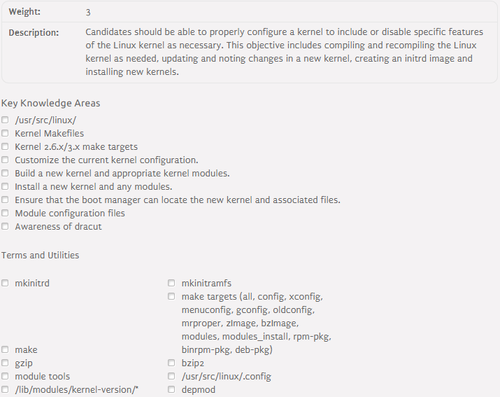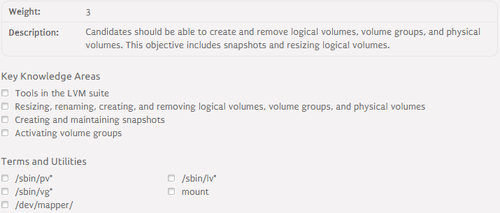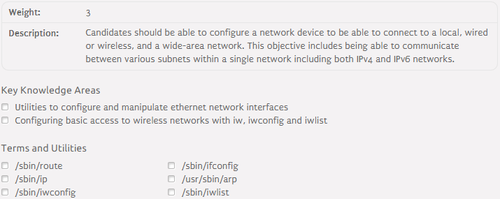LPIC-2-Scratchpad
Jump to navigation
Jump to search
LPIC-2-Scratchpad
201.2 Compiling a kernel⌘

Why to compile the kernel?⌘
- To enable specific drivers / modules
- To enable experimental features and drivers
- To modularize the kernel
- To reduce kernel size
- To develop kernel modules
- To reproduce the kernel used by someone else
- To pick up a girl :)
Kernel compilation and installation⌘
- Download kernel source code from the official Linux kernel website
- Extract kernel archive inside the /usr/src directory
- Configure the kernel using proper make target
- Compile the kernel into a desired format
- Compile kernel modules
- Install kernel modules
- Install the kernel
- Create initrd or initramfs
- Point the bootloader at the new kernel
Make targets⌘
- make config - configures the kernel using a CLI-base dialog
- make menuconfig - configures the kernel using a CLI-based menu
- make xconfig - configures the kernel using a GUI-based menu
- make oldconfig - configures the kernel using the .config file
- make - compiles the kernel in the vmlinux format
- make zimage - compiles the kernel in the zImage form
- make bzimage - compiles the kernel in the bzImage format
- make modules - compiles kernel modules
- make modules_install - installs kernel modules into the /lib/modules/ directory
- make mrproper - restores the build directory to its original state
Initrd and Initramfs⌘
- INITRD (INITial Ram Disk):
- initrd.img-[kernel version]
- image containing temporary file system binaries
- loaded into memory (/dev/ram device) during the boot process and mounted as an initial root filesystem
- contains programs necessary for hardware detection, kernel modules loading and hardware detection
- INITRAMFS (INITial RAM FileSystem):
- initramfs.img-[kernel version]
- cpio archive fulfilling the same functions as initrd, but omitting some of its limitations
- Management tools:
- mkinitrd - creates initrd
- mkinitramfs - creates initramfs
- Lab Exercise 201.2
204.3 Logical Volume Manager⌘

General concept and basic terms⌘
- LVM structure:
- Physical Volume - physical block device (e.g. partition, disk, RAID device)
- Volume Group - virtual container consisting of one or more Physical Volumes
- Logical Volume - virtual block device provided by the Volume Group
- Device Mapper - kernel driver which passes data from virtual device to block device
- /dev/mapper - contains files of virtual devices provided by the Device Mapper
- lvm2 - package containing LVM binaries and libraries
Physical Volume management tools⌘
- pvcreate - initializes a Physical Volume on the physical device
- pvremove - removes the Physical Volume
- pvdisplay - displays Physical Volume's attributes
- pvchange - changes Physical Volume's attributes
- pvs - displays Physical Volume's information
- pvresize - changes size of the Physical Volume
- pvscan - scans all system devices for Physical Volumes
- pvmove - moves physical extents from one Physical Volume to another
Volume Group management tools⌘
- vgcreate - creates a Volume Group from the Physical Volumes
- vgremove - removes the Volume Group
- vgdisplay - displays Volume Group's attributes
- vgchange - changes Volume Group's attributes
- vgrename - changes name of the Volume Group
- vgs - displays Volume Group's information
- vgextend - adds a Physical Volume to the Volume Group
- vgreduce - removes a Physical Volume from the Volume Group
- vgscan - scans all system devices for Volume Groups
- vgmerge - merges two separate Volume Groups into a single Volume Group
- vgsplit - splits the Volume Group into two separate Volume Groups
Logical Volume management tools⌘
- lvcreate - creates a Logical Volume from the Volume Group
- lvremove - removes the Logical Volume
- lvdisplay - displays Logical Volume's attributes
- lvchange - changes Logical Volume's attributes
- lvrename - changes name of the Logical Volume
- lvresize - changes size of the Logical Volume
- lvs - displays Logical Volume's information
- lvextend - extends size of the Logical Volume
- lvreduce - reduces size of the Logical Volume
- lvscan - scans all system devices for Logical Volumes
- Lab Exercise 204.3
205.1 Basic networking configuration⌘

Network interfaces configuration⌘
- Configuration files:
- /etc/network/interfaces - on Debian systems
- /etc/sysconfig/network-scripts/ifcfg-[interface name] - on RedHat systems
- Configuration tools:
- ifconfig - network interface configuration tool
- ifup - brings network interface up
- ifdown - brings network interface down
- Supporting tools"
- arp - displays ARP table
Wireless network interfaces configuration⌘
- Wireless network specific parameters:
- ESSID - wireless network name
- PSK - pre-shared key
- frequency, channel, modulation, etc.
- Configuration files:
- /etc/wpa_supplicant/wpa_supplicant.conf - wpa_supplicant configuration file
- Configuration tools:
- iwconfig - wireless network interface configuration tool
- iwlist - displays parameters of wireless network interfaces
- Most often configured via Desktop environment
Routing configuration⌘
- Manual:
- route command:
route add -net [network IP] netmask [SM] gw [next hop IP] [interface name]
- ip route command:
ip route add [network IP / SM] via [next hop IP] dev [interface name]
- Via configuration files:
- Debian (/etc/network/interfaces):
up [manual command]
- RedHat (/etc/sysconfig/network-scripts/route-[interface name]):
[network IP/ SM] via [next hop IP] dev [interface name]
- Lab Exercise 205.1

